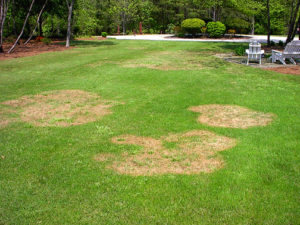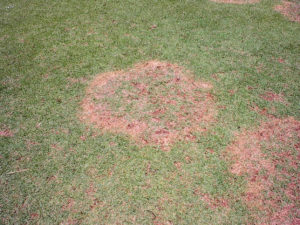 Winter Patch in warm season turf is caused by Rhizoctonia. This is the same fungus that causes Brown Patch in Fescue lawns. This problem usually appears between early March and mid May as the warm season turf begins to break dormancy and begins to green up for the year.
Winter Patch in warm season turf is caused by Rhizoctonia. This is the same fungus that causes Brown Patch in Fescue lawns. This problem usually appears between early March and mid May as the warm season turf begins to break dormancy and begins to green up for the year.
This is not necessarily a recurring problem but if it does develop each spring there may be factors in place in your lawn that are encouraging the disease development.
We see this problem not only in turf that is highly maintained, such as reel mowed turf, but also in normally mowed turf. Allowing your lawn to become dry in the fall prior to the first frost or allowing the thatch to build to an excessive level also encourages disease development.
 Compaction can also stress the turf by reducing root growth and vigor. Compacted soil produces weak turf that is very susceptible to winter patch development.
Compaction can also stress the turf by reducing root growth and vigor. Compacted soil produces weak turf that is very susceptible to winter patch development.
Ask yourself these questions:
- Are you aerating each spring to reduce compaction? If not schedule a core aeration for every single spring.
- Are you watering sufficiently during the fall prior to the onset of turf dormancy? Turf roots require water throughout the dormancy period.
- Are you mowing at a higher setting beginning in August to allow the turf root systems to rebuild and allow the plant to store enough energy for overwintering? Your warm season turf should be allowed to reach 3″ by dormancy.
- If you have answered yes to all these questions but still see fungal problems, then your growing environment coupled with previous weather patterns may simply be allowing the fungus to infect the turf.
Regardless, you may require a fall application of fungicide to help reduce the development in the spring of the disease. These treatments can be expensive and have variable results. Problem solving with correct maintenance practices are definitely the best remedy in most situations.
« Back to Glossary Index